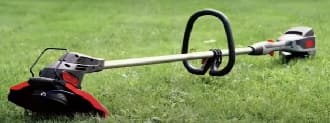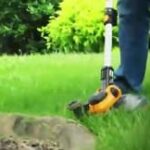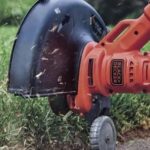As an Amazon Associate, this site earns commissions from qualifying purchases. For more information click here.
When it comes to trimming weeds, no tool does it better than a string trimmer. They are versatile for sure, but is it safe to use one near a vinyl fence?
A string trimmer can damage a vinyl fence if it makes contact with the boards. To prevent this, position the trimmer so the safety guard is between the fence and the string.
Why String Trimmers Can Damage Vinyl Fences
A string trimmer has the potential to cause damage because of its string. The string (or blade) are made of heavy duty material that slices weeds, grass and other materials. However it can also scar or cut through fences.
The string in a string trimmer spins so fast it stiffens and generates centrifugal force, allowing it to cut weeds easily. The thicker the string, the greater the cutting power.
This power is also the reason why your vinyl fence is at risk. If the string scrapes the fence, it can leave a mark or rip a board off entirely.
If your string trimmer is equipped with a metal blade, the potential for damage is even greater. Heavy duty blades can scar not just vinyl but also wood and other materials. The more powerful the trimmer, the sharper its blade or string.
For these reasons, some prefer to use a lawn mower instead of a trimmer. If you have a mower you can use that, but a string trimmer will work fine with the right approach.
If this is your first time to use a string trimmer and worried it might damage your fence, fear not. I will show you how to do it properly and what mistakes to avoid.
How to Protect Vinyl Fences From String Trimmers
While string trimmers can be risky, that does not mean you cannot use it near a vinyl fence. Here are the best ways to safeguard your fence from weed eaters.
Keep the string trimmer guard on. The guard is designed to protect you, but it also works as a safeguard for vinyl fences.
Use your string trimmer so that the guard is always positioned between the string or blade and the fence. Maintain this position as long as you are near the fence.
Some have argued string trimmers perform better without the guard. This is debatable, but even if performance does improve, it’s not worth it.
Never remove the guard. It is there for a reason. It isn’t just for fences and decks but also for you.
Elevate the fence. Raise it by 3-4 inches off the surface. This is sufficient to keep the fence safe from weed eaters and other trimming tools.
You can use wood or concrete blocks to raise the fence. But any materials will do as long it’s sturdy.
Set up a barrier. Put bricks, rocks, pots, or other materials between your vinyl fence and the weeds.
There is no shortage of usable materials. You can dump some gravel, soil or sand and that should work.
Create a stone border. This is similar to a barrier but provides more protection. Gather some cobblestones (basalt, sandstone, granite etc. any will do) and place them around the fence.
The stones do not have to be against the fence, a distance of 1-2 feet is fine. Once the cobblestones are set up, add some shrubs and plants.
How to Trim Weeds Near a Vinyl Fence
Note: you can use a gas, electric or battery powered string trimmer. If you are using an electric trimmer, make sure the cord is long enough to cover the entire area. If using a battery powered model, give it a full charge first.
If the trimmer head rotates counterclockwise, trim right to left. If the trimmer head turns clockwise, trim left to right. This is important so the string cuts the weeds smoothly.
If your vinyl fence doesn’t have any barrier or protection, make sure the trimmer guard is installed.
Hold the string trimmer so the guard is sandwiched between the fence and the weeds.
Move the trimmer close to the fence but without making contact. This is where having the guard and a border makes a difference. This video shows how to trim around a fence.
You might need to make a couple of passes to remove the grass. The initial pass is as close to the fence as possible while the second is for the finishing touch.
Hold the string trimmer at a 45 degree angle, always keeping the guard as protection. It is all right to press the guard onto the vinyl as you trim.
Trim slowly especially when near the fence. Even with a guard or barrier, you should never hurry the process.
Trimming Efficiency Guidelines
The key is to move slowly. Use the lowest setting for your string trimmer and trim as low as you can.
You don’t have to choose between a string trimmer and an herbicide. You can trim first and apply the herbicide after, or spray first and then cut the weeds off.
Set up a no-grass perimeter around the fence. Once it is set up, you can trim the grass inside it and apply herbicide.
Determine how large the no-grass area will be. You can measure 3-6 inches from the fence or whatever you preference.
Place stakes to mark the perimeter. Once the area has been marked, trim the weeds inside it.
If you have long grass to work on, cut in and out in the shape of the letter U. You will need a powerful string trimmer like the Husqvarna 128LD to do this.
If you followed these steps, you’ll have no problems trimming grass and weeds close to a vinyl fence. For this to work smoothly, your weed eater has to be in running condition.
If you have an Echo string trimmer and it refuses to start, you can try these solutions. Regular maintenance is essential for any trimming work especially if there is a lot of long, thick grass.
How to Keep Vinyl Fences Free From Weeds
Use an herbicide to prevent weeds from growing near your vinyl fence. There are a lot of options but I prefer Natural Elements because it contains natural ingredients and will not damage the fence.
Apply the herbicide according to the product instructions. Even if using natural products, be careful not to spill any on the fence.
What I usually do is I apply the herbicide and give it 2-3 days to work. After that I trim or mow over the grass. Since the herbicide kills the roots, the weeds will not grow again.
You can also do it in reverse order. Trim the weeds near the fence and apply the herbicide afterwards. Both methods will work.
If you set up a no-grass perimeter, put mulch in it. This is going to prevent the weeds from growing. Just add 2-3 inches of mulch and that is enough.

Tips for Trimming around Vinyl Fences
Wear eye protection. Most string trimmer related injuries involve the eyes, so wear safety goggles. You should also avoid baggy clothes because the fabric might get stuck on the trimmer.
I also recommend sturdy shoes or even steel toe footwear. Do not wear sandals or flip flops. You have to protect your feet.
Always focus on the trimmer head spin direction. If the head spins clockwise, the debris will fly on the right. If it rotates counterclockwise, the debris go to the left. So if you are trimming close to a vinyl fence, the debris could pile up there.
How to trim depends on your goal. Edging is ideal if you are trimming the perimeter and prefer a sharp, clear cut. You should move the weed eater so it is perpendicular to the grass and avoid hitting the fence.
If you want to give the grass a gradient look, hold the weed eater at an angle so it tapers off.

I love the outdoors and all the tools for maintaining gardens, yards and lawns. The only thing I am more passionate about is sharing what I know about garden and outdoor equipment.


